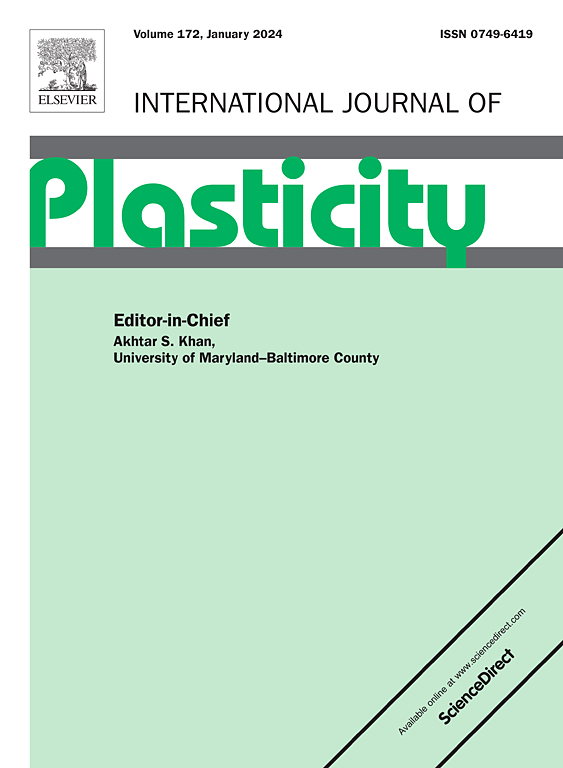通过调节溶质团和沉淀物实现铝-硅-铜-镁合金卓越的强度-电导率协同效应:实验验证和数值模拟
IF 12.8
1区 材料科学
Q1 ENGINEERING, MECHANICAL
引用次数: 0
摘要
本文对Al-8Si-2Cu-0.5Mg合金采用预时效+二次时效的双阶段时效策略,全面研究了预时效过程中溶质团簇的形成及其对二次时效过程中后续析出行为的影响。特别是,与单段时效(SA)相比,双段时效(DA) Al-8Si-2Cu-0.5Mg合金力学性能增强的强化和增韧机制已经被揭示。采用了cs校正透射电子显微镜(TEM)、原子探针断层扫描(APT)、第一性原理计算和分子动力学(MD)模拟相结合的方法。结果表明,在预时效过程中,Mg-Si-Cu有明显的团簇形成趋势。这种生长过程伴随着团簇内Mg的优先富集,即在165℃的二次时效过程中,团簇的Mg:(Si+Cu)比呈增加趋势。这导致在峰时效的DA Al-Si-Cu-Mg合金中存在高密度的Mg-Si-Cu团簇和混合亚单元析出物,这表明了优异的强度和延展性协同作用。SA和DA合金的屈服强度(YS)几乎相同(~ 295 MPa),而DA合金的延伸率(EL)(~ 14.2%)优于SA合金(~ 9.2%)。MD模拟阐明了增韧机制,即Mg-Si-Cu团簇和混合亚单元析出物诱导弱应力集中,为优化强度-塑性平衡提供了可行的选择。该研究为Al-Si-Cu-Mg合金在时效过程中的组织演变提供了有价值的见解,为Al-Si-Cu-Mg合金的强度-塑性协同提供了潜在的途径。本文章由计算机程序翻译,如有差异,请以英文原文为准。


Superior strength-ductility synergy of Al-Si-Cu-Mg alloys achieved by regulating solute clusters and precipitates: Experimental validation and numerical simulation
In this work, a double-stage aging (i.e., pre-aging plus second-aging) strategy has been conducted on an Al-8Si-2Cu-0.5Mg alloy to comprehensively investigate the formation of solute clusters during pre-aging and their impact on the subsequent precipitation behavior during second-aging. Particularly, strengthening and toughening mechanisms for enhanced mechanical properties of the double-stage aged (DA) Al-8Si-2Cu-0.5Mg alloy have been revealed in comparison to the single-stage aged (SA) counterpart. A combination of Cs-corrected transmission electron microscope (TEM), atom probe tomography (APT), first-principles calculations and molecular dynamic (MD) simulations is employed. The results reveal a marked tendency for Mg-Si-Cu cluster formation during pre-aging. This cluster growth is accompanied by preferential Mg enrichment within the clusters, i.e., the Mg:(Si+Cu) ratio of clusters shows an increasing trend during second-aging at 165 °C. This results in a high density of both Mg-Si-Cu clusters and mixed sub-unit precipitates in the peak-aged DA Al-Si-Cu-Mg alloy, which demonstrates a superior synergy of strength and ductility. The yield strength (YS) of both the peak-aged SA and DA alloys are nearly identical (∼295 MPa), while the elongation (EL) of the peak-aged DA alloy (∼14.2 %) is superior to that of the peak-aged SA alloy (∼9.2 %). MD simulations elucidate the toughening mechanism, i.e., Mg-Si-Cu clusters and mixed sub-unit precipitates induce weak stress concentrations, present a viable option for optimizing the strength-ductility balance. This research provides valuable insights into the microstructure evolution of Al-Si-Cu-Mg alloys during aging treatments, offering potential avenues for strength-ductility synergy of Al-Si-Cu-Mg alloys.
求助全文
通过发布文献求助,成功后即可免费获取论文全文。
去求助
来源期刊

International Journal of Plasticity
工程技术-材料科学:综合
CiteScore
15.30
自引率
26.50%
发文量
256
审稿时长
46 days
期刊介绍:
International Journal of Plasticity aims to present original research encompassing all facets of plastic deformation, damage, and fracture behavior in both isotropic and anisotropic solids. This includes exploring the thermodynamics of plasticity and fracture, continuum theory, and macroscopic as well as microscopic phenomena.
Topics of interest span the plastic behavior of single crystals and polycrystalline metals, ceramics, rocks, soils, composites, nanocrystalline and microelectronics materials, shape memory alloys, ferroelectric ceramics, thin films, and polymers. Additionally, the journal covers plasticity aspects of failure and fracture mechanics. Contributions involving significant experimental, numerical, or theoretical advancements that enhance the understanding of the plastic behavior of solids are particularly valued. Papers addressing the modeling of finite nonlinear elastic deformation, bearing similarities to the modeling of plastic deformation, are also welcomed.
 求助内容:
求助内容: 应助结果提醒方式:
应助结果提醒方式:


